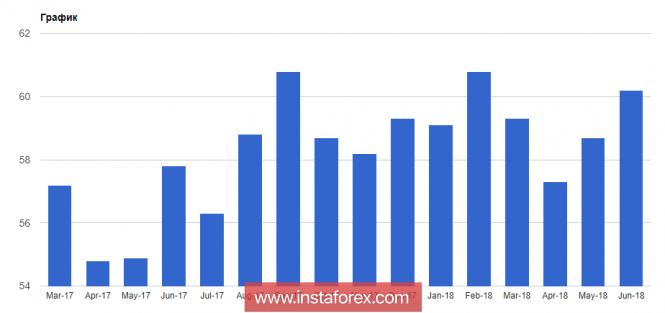The European currency fell yesterday afternoon, as investors feared that German Chancellor Angela Merkel would not be able to solve the immigration policy problem and allow a split in her conservative bloc that would lead to the collapse of her coalition government. However, by the close of the North American session it became known that the German parties of the CDU and CSU reached an agreement on migration, which led to a sharp increase in risky assets, including the euro.
As Angela Merkel said, the reached agreement on migration allows preserving cooperation with the EU countries, and also allows the regulation of the secondary migration flow of refugees.
Data released by the US economy also supported the US dollar.
According to the report of the institute of supply management ISM, the index of supply managers PMI for the manufacturing sector in June this year rose to 60.2 points against 58.7 points in May. It is important to note that a value above 50 indicate an increase in activity. Economists had expected that in June, the index would be at 58.1 points.

However, the indicator of industrial activity in the US for June seriously decreased. According to the IHS Markit report, the PMI's supply managers' index for the manufacturing sector fell to 55.4 points in June 2018 from 56.4 points in May. As noted in Markit, the drop in the index was directly related to the slow growth in production and new orders.
Expenses for construction in the US for May increased. According to the US Department of Commerce, expenses increased by 0.4% compared to the previous month and amounted to 1.309 trillion US dollars. Economists were expecting an increase in expenses by 0.7%. Data for the previous month were revised downward.
As for the current technical picture of the EURUSD pair, it remained unchanged after yesterday's surge in buyers. The eurodollar still needs a return and consolidation above the intermediate resistance level of 1.1660. Only a breakthrough in this range will allow us to count on a further upward trend with the update of the highs to around 1.1720 and 1.1780. In case of a decline in the euro, more support will be provided by the area of 1.1570.
The Australian dollar also strengthened its position against the US dollar, despite weak data on consumer confidence in Australia.
According to the report of ANZ-Roy Morgan, consumer confidence in Australia fell by 0.8%, to 120.4 points. The main pressure on the index was created at the expense of fears about future economic conditions.
The material has been provided by InstaForex Company - www.instaforex.com